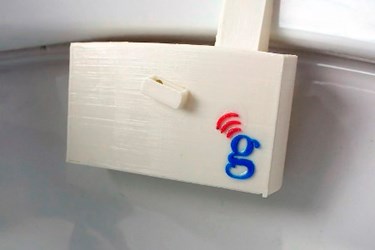Needle-Free Diabetes Management Device Tests Glucose Levels In Urine

Mexican scientists have developed a glucose testing method that does away with finger-stick tests by measuring glucose levels in urine. By placing the device in the toilet, patients can easily monitor their day-to-day glucose levels at home and share the information wirelessly with caregivers and doctors. The device’s inventors also claim it will be less expensive overall than current glucometers.
The current standard in at-home glucose monitoring uses a system of finger-stick blood samples, test strips, and portable meters. Since the technology was introduced thirty years ago, diabetes patients have been able to take a more active role in the management of their disease, but the system is not without flaws. Regular, painful finger-sticks and expensive test strips can be prohibitive for patients and, in some cases, interfere with treatment compliance.
Carlos Bernal and Nancy Guerra, two scientists from the Technological Institute of Chihuahua, said in a press release that eliminating the finger-stick was their top priority when they began developing the Glucosalarm, a device that uses urine rather than blood to monitor glucose.
“Pricking a finger several times a day can lead to numbness and over sensitivity to the simple touch of clothing, even the whole hand can become too painful to use for three or four days,” said Bernal.
The Glucosalarm fits inside the toilet and collects a few drops of the patient’s urine after being activated via Bluetooth. Inside the collector, the urine mixes with enzymes that cause the glucose present within the sample to change color, which is then analyzed and calculated into a glucose level. Results are sent to the phone within 15 to 40 seconds.
“Using the smartphone, the patient can send results to a doctor, family member or diabetes educator responsible for treatment, so that they are aware of the day-to-day glucose measurement,” said Bernal, who added that the device could also alert emergency services if the number is dangerously high.
Bernal, who was recognized by MIT as a top innovator under the age of 35, said that his team’s device would be more expensive upfront — between $120 and $130 — but it will not require a constant supply of test strips, often the most expensive component of a glucose monitoring system. Readings for Glucosalarm will cost approximately a penny per measurement, he said.
Pending necessary FDA authorizations, the Glucosalarm could be on the U.S. market in early 2017, and according to Bernal, several top medical device companies have expressed interest in manufacturing it.
In recent years, top names in the industry have invested heavily in designing systems that remove the needle from glucose monitoring. Proposed solutions include everything from continuous glucose monitoring (CGM) systems that implant a tiny sensor under the skin to contact lenses that can take readings from tears and transmit them wirelessly to an external device.
Manya Aggarwal, senior analyst for Decisions Research Group, recently stated in a MedDeviceOnline column that, in order to succeed in the market, new devices indicated for diabetes management must “minimize or remove the human aspect” in the monitoring process and must address compliance issues associated with needles.
Over 29.1 million Americans, 9.3 percent of the population, suffer from diabetes, which costs over $116 billion a year to treat. Researchers from Temple University estimate that hypothetical 100 percent compliance with diabetes management could save the U.S. health system $9.3 billion per year.
